 | |
           2026 Sistema Cheve |
1987 Wakulla Springs Expedition Photos
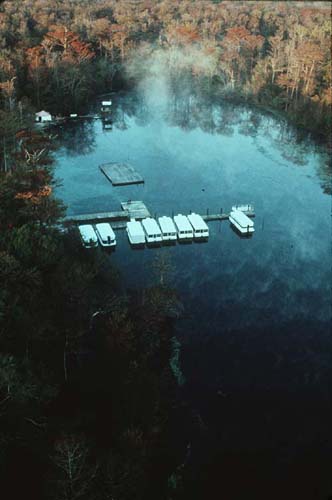 Aerial view of Wakulla Spring taken during October of 1987. The white rectangular craft are glass bottom boats used by the park to give tours of the spring. 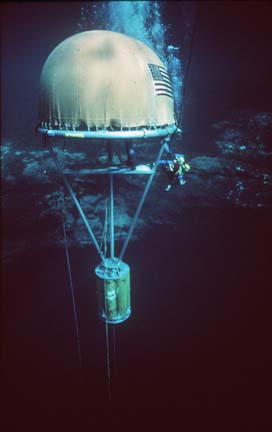 Final assembly and checkout of the variable-depth underwater habitat design for the Wakulla 1 project. Made possible by a generous grant from Rolex USA, the habitat could be pre-stationed at -25 meters before the start of an exploration mission and then used for all decompression from there to the surface. An internal chain hoist permitted the returning exploration crew to gradually allow the hemispherical living quarters to rise to the surface in a controlled fashion. 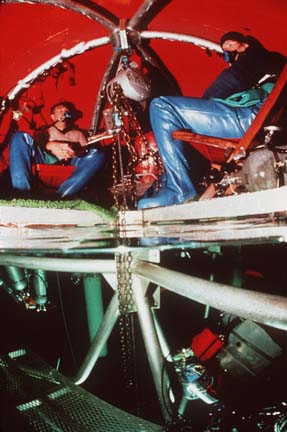 Comfortable decompression is being enjoyed by Paul DeLoach (left) and Sheck Exley following the second push on A-Tunnel in November of 1987. The habitat allowed for the attachment of K-bottles of pure oxygen for decompression. Overboard dumps on the exhaust regulators prevented the oxygen concentration from becoming too high inside the hemisphere. A 125 cubic-foot-per-minute Ingersoll-Rand air compressor was used to purge carbon dioxide from the dome. 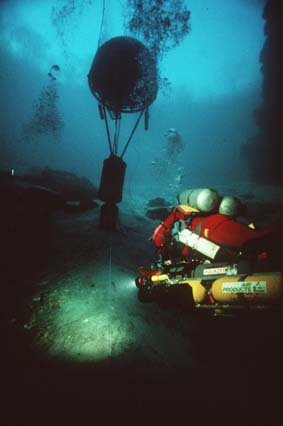 Returning home from a long trip up B-Tunnel, Rob Parker heads for the habitat. Maximum mission durations in 1987 were on the order of 80 minutes and required divers to carry 8 to 10 scuba tanks each. Sleds attached to the bottoms of the diver propulsion vehicles (DPVs) allowed up to 4 composite high pressure tanks to be efficiently carried with the diver. 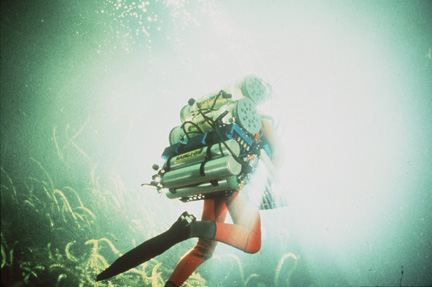 Sheck Exley tests the Cis-Lunar MK1 prototype rebreather, December 11, 1987. Weighing a whopping 205 pounds (93 kg) the unit was not considered "portable" and had to be wheeled into the spring on a dolly, yet underwater it was neutrally buoyant. The unit had outrageous range and was also fully redundant, meaning it contained two complete rebreathers within the one backpack. Shortly before this dive Bill Stone used the rig to conduct a 24-hour dive in Wakulla Basin. Only one half of the rig was used for this dive, meaning that a 2-day underwater mission could have been carried out. This was the first rebreather to utilize multiple, redundant computer systems for electronic control of the life support backpack. It was also the first rebreather to use lithium hydroxide to remove carbon dioxide from the breathing loop and contained novel concepts to permit the safe use of that material. 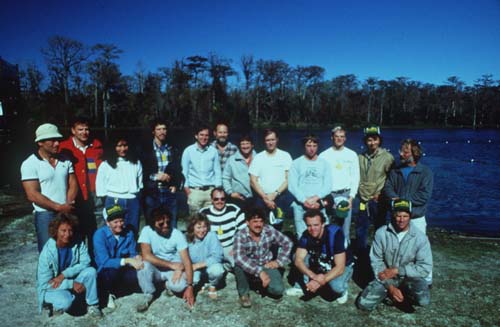 Team photo, early December 1987: Rear, left to right: Angel Soto, Paul DeLoach, Tara Tanaka, Bill Stone, Dale Sweet, Sergio Zambrano, Sheck Exley, Noel Sloan, Rob Parker, Clark Pitcairn, Chris Brown, Pete Scoones. Front row, left to right: Georgette Douwma, Mary Ellen Eckhoff, Leo Dickinson, Mandy Dickinson, Wes Skiles, Paul Heinerth, Gavin Newman, Brad Pecel. |
| Copyright © 2025 U.S. Deep
Caving Team, Inc. All rights reserved. Todo el contenido tiene derechos de autor del U.S. Deep Caving Team. Todos los derechos reservados. No portion of these pages may be used for any reason without prior written authorization. | |

